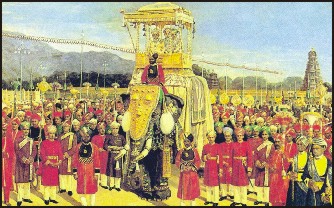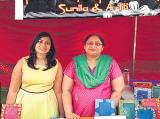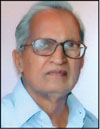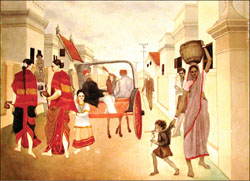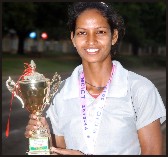
Last month I went to a friend in Vontikoppal on some personal errand. Ah! He was overjoyed. It was a Sunday and wanted to host a pure vegetarian Madhva lunch served seated on a low bench, food served on a banana leaf…
Since it was lunch time I agreed more to make my friend happy than to satiate my gourmet taste. However, as we got down from the car, my friend mentioned of an interesting house nearby on the same road that he would like to show me. That was how we forgot about the Madhva Bhavan lunch and moved to a house eponymously named ‘Chitralaya,’ a sort of art gallery with mementoes in memory or in honour of a patriarch of the family who was also a well-known artist — painter, sculptor, craftsman — M. Veerappa, the man behind the famous Mysore Toys. He is also known as the first person, nay artist, to paint pictures, both water colours and oil on canvas, based on subjects from Vachana Sahitya of Saint Basavanna.
I was told M. Veerappa (1901-1969) lived here in his house which was demolished and a new one was built with the name ‘Chitralaya’ by his grandson Sanjay, an industrialist who is the son of Veerappa’s second son Gowrishankar. Apparently in partition, Gowrishankar must have inherited the property and now his son Sanjay.
M. Veerappa was one of the five sons and three daughter of his parents Muddappa and Gangamma, running a provision store at Hosur, border of Tamil Nadu and Karnataka, near Bengaluru. Though there was no history of anyone in the family having artistic talent, Veerappa was seen painting pictures from the books he was reading as a student. While none in the family, including his parents, took Veerappa’s interest in painting seriously, interestingly, it was a journalist who noticed the boy’s talent and decided to help him in his passion.
Reading about this incident from a booklet given to me by Sanjay, I was delighted for two reasons. After all, I too am a journalist and more importantly the name of the newspaper of which the journalist Y. Virupakshiah was the editor was ‘Mysore Star’ since defunct. I think this city Mysuru can’t resonate to its people without a newspaper bearing the name ‘star,’ so we have now a ‘Star of Mysore’ newspaper since 1978! Pardon me if I sound immodest !!
This Virupakshiah of a journalist-relative had gone to Hosur for a wedding where he saw the works of this young boy and was impressed. He urged Veerappa’s parents to send the boy with him to Mysore to school him properly in arts. He was admitted to Chamaraja Technical Institute (CTI) on Sayyaji Rao Road, now known as Chamarajendra Academy of Visual Arts (CAVA). Rest was history. Veerappa never looked back thereafter. Wonder, how one noble gesture on the part of a journalist changed the course of life of an individual.
Once again it was another noble gesture on the part of a Judge, G. Paramashivaiah, that enabled Veerappa to further his studies in art and sculpture at the famous JJ School of Arts, Bombay. Veerappa must be a lucky person to get help in his early life in this manner. Rightly it is said luck is when opportunity meets preparation. He had the preparation (talent) and got the opportunity, thanks to noble persons like Y. Virupakshiah and G. Paramashivaiah. And luck smiled on him.
Veerappa later joins CTI as a teaching faculty and heads the Fine Arts Section, becoming the Assistant Superintendent. He was also running a toy manufacturing unit which became famous as Mysore Toys. He had also gone to Japan sponsored by Government of India for training in packaging.
I learn that M.S. Nanjunda Rao, who established Mysore Chitrakala Parishat, now Karntaka Chiktrakala Parishat, in Bengaluru, was the student of M. Veerappa. Two of his sons, Praful Chandra, an octogenarian, was carrying the tradition of Mysore Toys till recently while his brother Shivanna set up his own unit known as ‘Wood Life’ which made a name for itself.
Other children pursued different vocations but one of his grandsons, as I mentioned earlier, Sanjay Gowrishankar, an industrialist, has set up a mini museum-gallery of Veerappa’s works in his house ‘Chitralaya.’ Worth visiting by those who have an interest in fine arts and crafts. I was immensely happy to have visited this gallery-cum-house, a sort of two-in-one-house!
While leaving the gallery, I expressed my appreciation for taking so much trouble and providing so much space in his living house to show-case the works of his grandfather and commemorate his memory. Sanjay Gowrishankar said ‘thank you’ and a modest man he is, he added: “But I must admit it is because of my wife Sowmya’s dedication and passion that we are able to present the gallery at its visual best with cleanliness.”
By now it was past 2 0’ clock and the aroma of a Madhva meal was seducing us!
e-mail: kbg@starofmysore.com
source: http://www.starofmysore.com / Star of Mysore / Home> Abracadabra…..Abracadabra / October 19th, 2015
